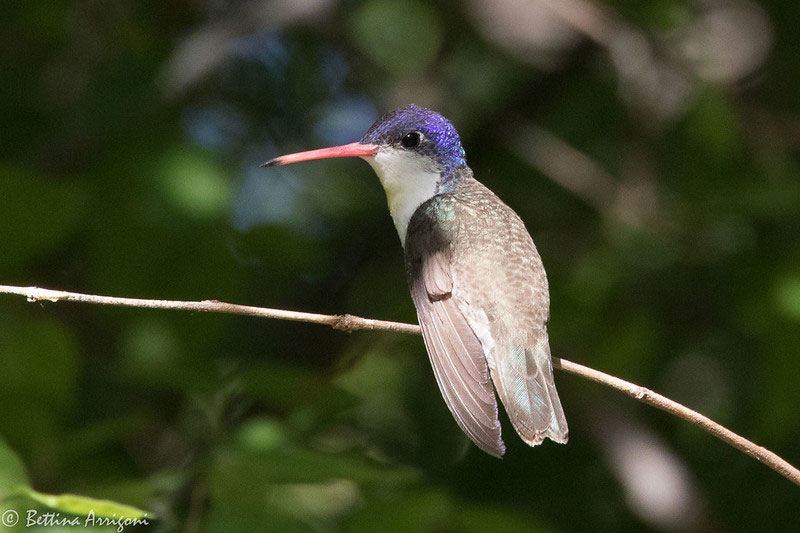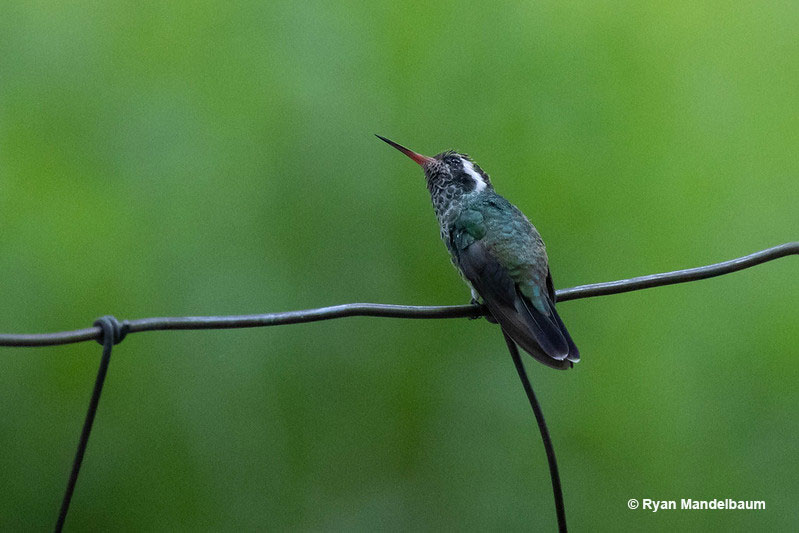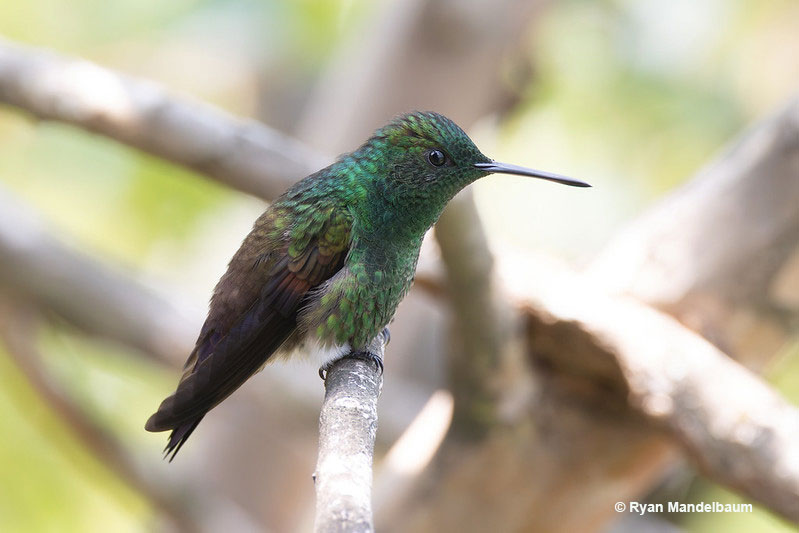
How many types of hummingbirds live in the USA and Canada? More than most people realize! While most folks east of the Rockies only see the Ruby-throated Hummingbird, 15 additional species also occur!
Most are common, while two species, The White-eared Hummingbird and the Berylline Hummingbird, are rare breeders. Amazingly, six more hummingbird species also occur as rare vagrants!
Hummingbirds definitely live in the fast lane. Most breed when certain flowers are in bloom, they have very high metabolisms, and only live for around five years.
Incredibly, some of these tiny birds also migrate thousands of miles and even fly over the Gulf of Mexico.
Want to learn about the 16 hummingbird species that live in the USA and Canada? Then keep on reading!
On this page
- Most Common Hummingbird Species in the U.S.
- 1. Anna’s Hummingbird
- 2. Ruby-throated Hummingbird
- 3. Black-chinned Hummingbird
- 4. Allen’s Hummingbird
- 5. Rufous Hummingbird
- 6. Broad-tailed Hummingbird
- 7. Costa’s Hummingbird
- 8. Broad-billed Hummingbird
- 9. Calliope Hummingbird
- 10. Rivoli’s Hummingbird
- 11. Buff-bellied Hummingbird
- 12. Violet-crowned Hummingbird
- 13. Lucifer Hummingbird
- 14. White-eared Hummingbird
- 15. Berylline Hummingbird
- 16. Blue-throated Mountain-gem
- Types of Hummingbirds – Frequently Asked Questions
Most Common Hummingbird Species in the U.S.
Using eBird data from 2022 to 2023, we listed them with the most common hummingbirds on top. We also included key information about each of these special little birds!
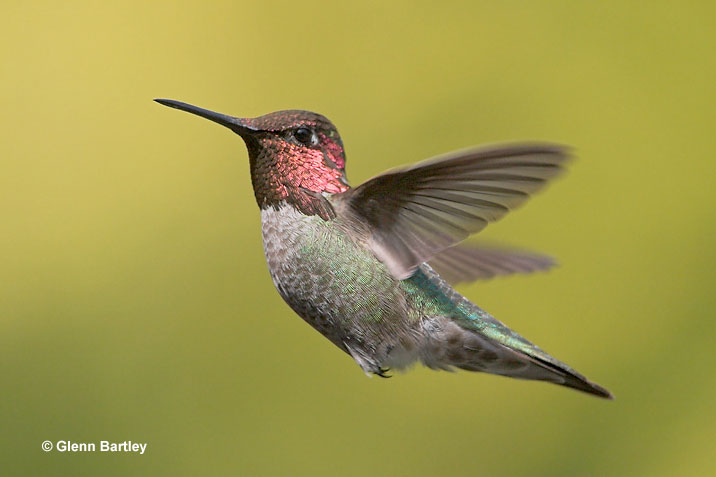
1. Anna’s Hummingbird
Size: 4 inches
The Anna’s Hummingbird is the common small hummingbird of the western coast. If you see a hummingbird in gardens from Washington to California and even Arizona, you might be seeing this pretty species.
We can recognize Anna’s Hummingbirds by their dusky green belly and the male by the shining magenta colors on his head. Like other hummingbirds, they hover while taking nectar from small flowers and feeders.
Related: Best hummingbird feeders to attract hummers
Historically, Anna’s Hummingbirds only lived in southern California and in Baja California. However, since then, gardens with exotic plants have helped it expand all the way to Washington and Vancouver!
In courtship, males of this species fly 130 feet up and then dive straight down while making an odd noise with their tails.
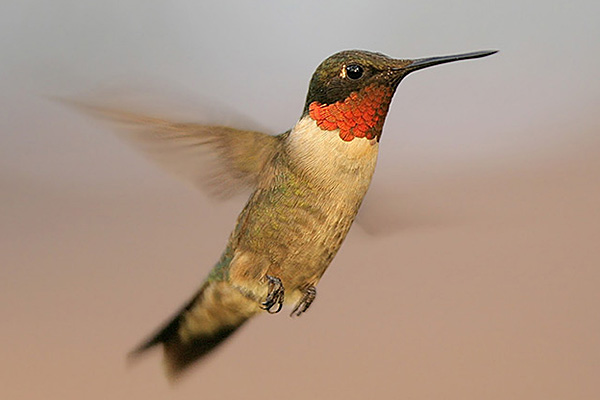
Photograph © Greg Lavaty.
2. Ruby-throated Hummingbird
Size: 3.75 inches
The Ruby-throated Hummingbird is the main hummingbird that breeds east of the Rocky Mountains. Usually, any hummingbird seen in eastern Canada and the eastern USA is this beautiful little bird.
These common birds have a large population and live in woodlands. They also visit gardens with feeders, especially during migration.
We can recognize males by their shining orange-red throats and forked black tails. Females have a black and white tip on their tail, a hint of a dark mask, and a small pale spot behind each eye.
As with other hummingbirds, Ruby-throateds spend most of their time feeding from flowers and feeders. They also chase other hummingbirds away from their food sources!
The Ruby-throated Hummingbird has one of the most amazing migrations of any bird. Each year, they fly all the way to Central America for the winter. When they migrate back north, many fly directly over the waters of the Gulf of Mexico!
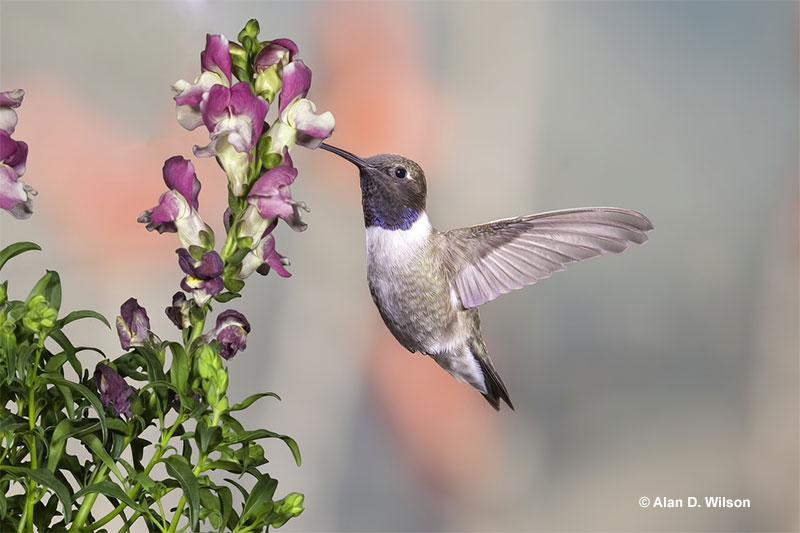
3. Black-chinned Hummingbird
Size: 3.75 inches
The Black-chinned Hummingbird replaces the Ruby-throated Hummingbird in many areas west of the Rocky Mountains. It frequents gardens, brushy areas, and riparian zones, especially in arid western habitats.
In many places, the Black-chinned Hummingbird is the most common hummingbird species, especially in western interior states like Utah and Nevada. We can recognize males by their black and dark purple throats, and dark forked tails.
Females have golden-green upperparts, a small pale spot behind each eye, and a black and white tip on their tail.
Black-chinned Hummingbirds hover while feeding from low flowers. They also commonly visit feeders where they sip nectar and chase other hummingbirds around.
Related: 15 plants to attract hummingbirds
This bird’s eggs are the size of a coffee bean! They lay them in nests made of soft vegetation and spider silk that expand as the young birds grow.
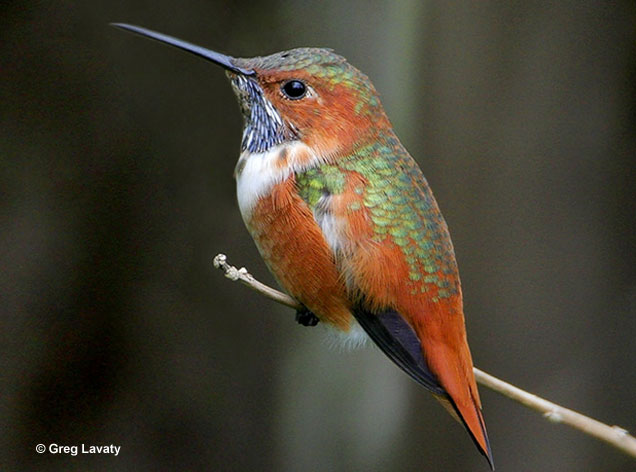
4. Allen’s Hummingbird
Size: 3.75 inches
The Allen’s Hummingbird only breeds in moist coastal habitats from Oregon to southern California. These pretty little birds are common in coastal scrub and nearby riparian zones and also in gardens around Los Angeles and San Diego.
Allen’s Hummingbirds can be recognized by their orange underparts combined with a green back and white breast. Males have a beautiful, shiny, copper-colored throat, while females are mostly orange with green upperparts and a speckled throat.
This species often visits feeders and also hovers while taking nectar from flowering bushes. Unlike most other birds, they can arrive on breeding grounds in December and leave by late May!
Related: Where do hummingbirds go in the winter?
Northern birds migrate all the way to central Mexico, while Allen’s Hummingbirds from southern California stay put all year long.
During courtship and territorial displays, males fly 90 feet up and then dive down while making a shrill sound with their tail feathers!
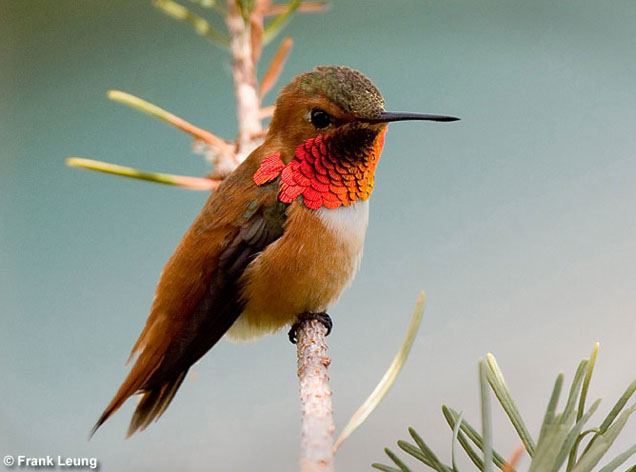
5. Rufous Hummingbird
Size: 3.75 inches
The Rufous Hummingbird breeds from southern Alaska to Oregon; further north than any other hummingbird! It arrives on its breeding grounds in early spring, stays there until mid summer, and then migrates south through the western USA.
Rufous Hummingbirds live in coniferous forests as well as in gardens and other habitats. They aren’t shy about visiting feeders and are aggressive birds that chase other hummingbirds away, even larger species!
Related: Best Bird Apps For Identification
We can recognize the male Rufous Hummingbird by its mostly orange plumage and orange/copper-colored throat. Females are mostly orange with green upperparts and look very similar to the female Allen’s Hummingbird. However, with a close look, we can see that the Rufous Hummingbird has “notched” tail feathers.
Rufous Hummingbirds have longer lifespans than other small hummingbird species and make an incredible journey twice per year. Some of them fly 3,900 miles from Alaska to Mexico and then back again in early spring!
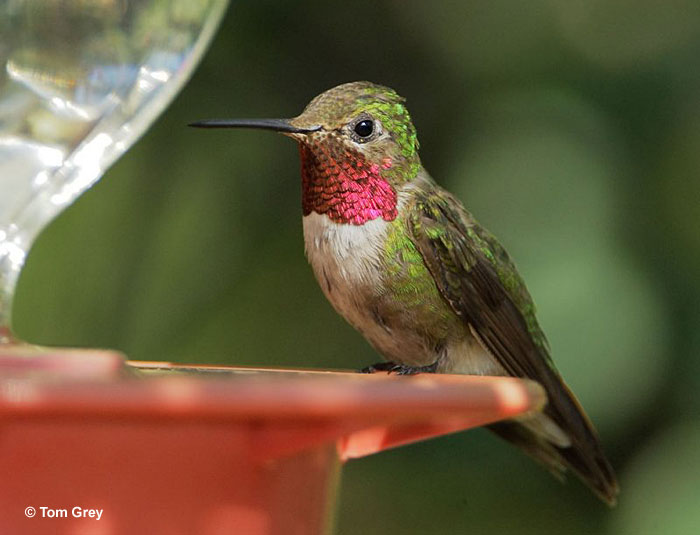
6. Broad-tailed Hummingbird
Size: 4 inches
The Broad-tailed Hummingbird is one of the main hummingbirds of the Rocky Mountains. It breeds in scenic montane meadows and other brushy habitats from Idaho south to Texas, Mexico, and even Guatemala.
Birds that breed in the USA also migrate to Mexico for the winter. We often see them feeding in low vegetation but also find them at feeders.
Sometimes, a Broad-tailed Hummingbird or two can even reach feeders in parts of the eastern USA.
We can recognize males by their dark pink or rose-red throat and buffy underparts. Females have buffy underparts, a speckled throat, and a bit of orange on each side of the base of their tail.
When flying around, male Broad-tailed Hummingbirds make a trilling sound with their wing feathers. They are also aggressive birds that constantly chase other hummingbirds away from their food.
On cold nights, this species survives by lowering its body temperature and entering into a temporary state of hibernation!
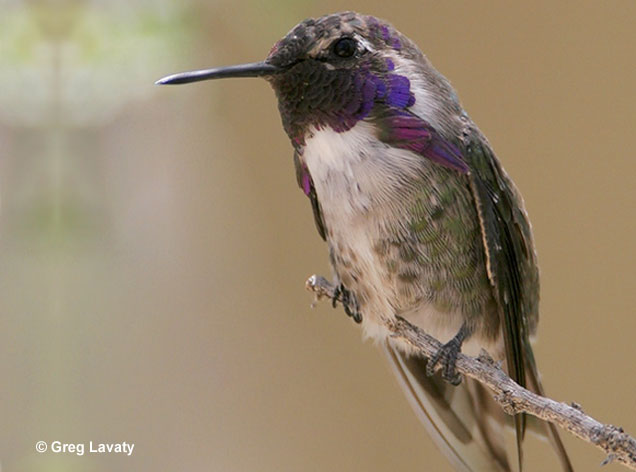
7. Costa’s Hummingbird
Size: 3.5 inches
The Costa’s Hummingbird is a small, common hummingbird of southwestern deserts. We can watch this exquisite bird in southern California, Arizona, northwestern Mexico, and parts of Nevada, Utah, and New Mexico.
In their range, Costa’s Hummingbirds are common visitors to cactus flowers, flowering bushes, and hummingbird feeders. Although they can get chased by larger hummingbirds, keep watching, they’ll come back!
We can recognize males by the iridescent, dark purple colors on their heads, and flared throat patch or gorget. Females look like small, pale hummingbirds with a pale, narrow eyebrow and line on the back side of their face.
Related: Hummingbird tattoo ideas & meanings
This hummingbird is common in desert vegetation but also visits gardens. They spend a lot of their time feeding and can visit flowers and feeders 1,800 times each day!
Sometimes, we see male Costa’s Hummingbirds doing their fancy courtship displays. The male makes loops and dives near the female while also emitting high-pitched whistling sounds.
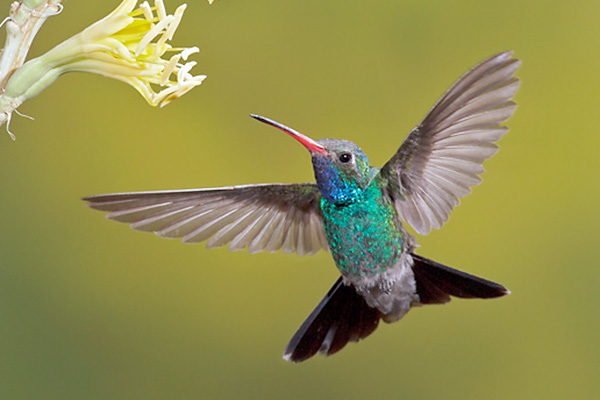
8. Broad-billed Hummingbird
Size: 4 inches
In North America, Broad-billed Hummingbirds are summer residents in southeastern Arizona and adjacent New Mexico. We find it in canyons with lots of sycamores and mesquite, but it can also visit nearby gardens.
Most Broad-billed Hummingbirds live in dry tropical forests in western Mexico, the same areas where North American birds spend the winter.
It’s pretty easy to recognize male Broad-billed Hummingbirds. These beauties are green with a purple-blue throat. They also have a red beak with a dark tip and a small white spot behind each eye.
Females have the same red beak but are gray below, have a dusky mask, and a white line on the back part of their face.
Broad-billed Hummingbirds are regular at feeders and also spend a lot of time feeding at flowering bushes. Like other hummingbirds, they have a voracious appetite and consume 1.7 times their body weight in nectar every day!
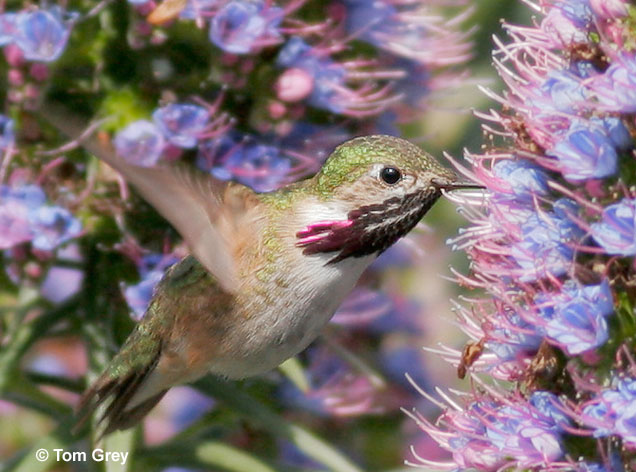
9. Calliope Hummingbird
Size: 3.25 inches
The Calliope Hummingbird is a tiny hummingbird that breeds in open coniferous woodlands and brushy habitats. It spends the breeding season in parts of western Canada and from eastern Washington to Utah and mountains in California.
After breeding, they migrate through the western USA to western and southern Mexico. We see this little gem in bushy habitats with flowers and also at feeders. However, on account of their small size, other hummingbirds often chase them away.
Even so, they aren’t shy about chasing larger birds from their nesting territories. They have even been seen flying at Red-tailed Hawks!
We can recognize Calliope Hummingbirds by their small size, slender, straight beak, and white line just above and next to the base of their bill. Males also have a streaked, rose-red throat.
The Calliope Hummingbird isn’t just a small bird. This species is the smallest bird in the USA and Canada, and one of the tiniest birds in the world!

10. Rivoli’s Hummingbird
Size: 5.25 inches
The Rivoli’s Hummingbird is a big, dark hummingbird of southeastern Arizona and southwestern New Mexico. It also lives in montane forest habitats from Mexico to Nicaragua.
In North America, we see Rivoli’s Hummingbirds in mountain pine-oak forests and forested canyons. Incredibly, these fancy birds are also regular at feeders!
Related: How to attract hummingbirds?
Males are dark green with a black head and underparts and have a small white spot behind each eye. When they turn their head, they show a luminescent, shining green throat and a beautiful purple crown.
Females are much duller green and gray, have a streaked throat, a white line going back from their eyes, and a white line on the lower part of their face.
The Rivoli’s Hummingbird visits feeders but also moves through the forest to feed from several different flowers.
This species has one of the highest heart rates of any animal. It can be anywhere from 420 to 1,200 beats per minute!
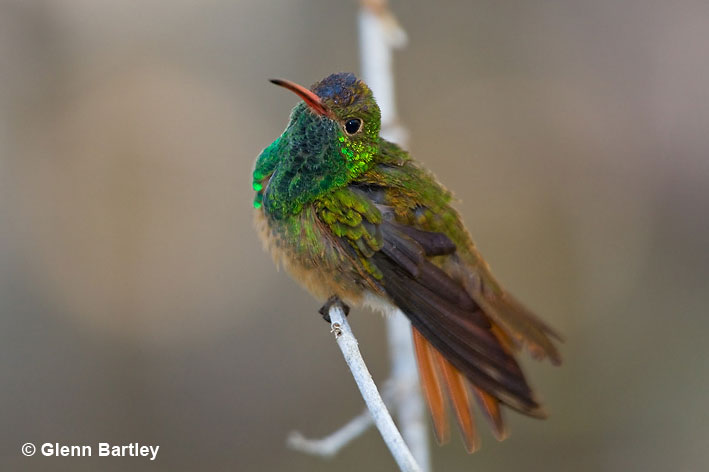
11. Buff-bellied Hummingbird
Size: 4.25 inches
The Buff-bellied Hummingbird is one of the common small hummingbirds of southern Texas. Although this species mostly lives in eastern Mexico, it also ranges to subtropical habitats in the Lower Rio Garnde Valley.
In winter, some Buff-bellied Hummingbirds also move along the Gulf Coast east to Louisiana and even western Florida. In its normal range, this hummingbird is common, easy to see, and often comes to feeders.
It’s also an easy hummingbird to recognize. This medium-sized hummingbird is green and has a buff-colored belly and red-brown tail. They also have a slightly curved red beak with a dark tip.
Male and female Buff-bellied Hummingbirds look pretty similar, but males have brighter throats and brighter red beaks. At feeders and flowers, this species often chases other hummingbirds away.
Like many other hummingbirds, in the morning, they often catch small insects in flight.
12. Violet-crowned Hummingbird
Size: 4.5 inches
The Violet-crowned Hummingbird is a striking hummingbird species that mostly lives in Mexico. Although it is common in that country, in the USA, Violet-crowned Hummingbirds are an uncommon species that only occur in southeastern Arizona and adjacent New Mexico.
They live along desert rivers and other riparian zones at lower elevations, almost only in places with Arizona Sycamores. However, they will also visit gardens with flowering bushes and feeders near riparian zones.
Related: Hummingbird Facts
We can recognize this beauty by its white underparts, olive upperparts, and violet blue on its head. They also have a small white spot behind each eye and a bright red beak with a dark tip. Males and females look similar, although young birds don’t show as much color on their heads or beaks.
Violet-crowned Hummingbirds spend most of their time foraging at flowers in riparian zones and also nest in the same habitat. For this reason, they are susceptible to the alteration of riparian woodlands.
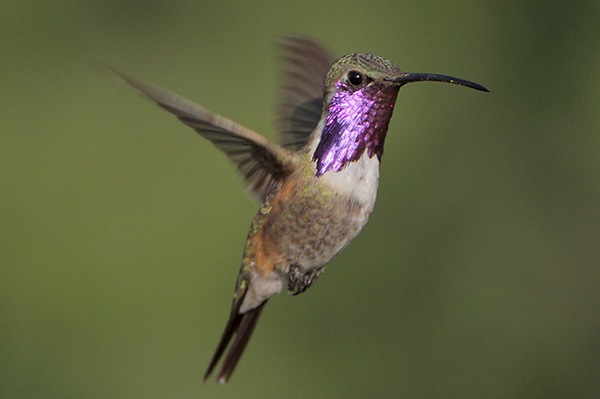
13. Lucifer Hummingbird
Size: 3.5 inches
The Lucifer Hummingbird is a small, exquisite desert hummingbird that mostly lives in Mexico. However, small numbers are summer residents in the Big Bend area of Texas, and some also visit southeastern Arizona.
In the USA, this species is uncommon and usually tied to agave and other desert plants that flower after summer rains.
Once in a while, it also shows up at feeders. However, to find them, birders usually need to know where desert plants are blooming.
Male Lucifer Hummingbirds look a bit like a male Ruby-throated Hummingbird with a much more curved beak and a longer tail. They also have a flared, violet or magenta throat. Females have the same curved bill as well as a hint of an olive mask, and a buff band on their chest.
Unlike any other hummingbird species, male Lucifer Hummingbirds display to females when the female is already sitting on her nest.
14. White-eared Hummingbird
Size: 3.75 inches
The White-eared Hummingbird is a small and handsome bird that lives in highland forest habitats. This species is one of the most common hummingbirds in Mexico and northern Central America. However, in the USA, the White-eared Hummingbird is a rare breeder and migrant to southeastern Arizona.
This species feeds at low flowering plants in and near forests. However, they can also visit gardens and are usually seen at feeders, with their tongues shooting out to enjoy the sugar water.
We can recognize White-eared Hummingbirds by the broad white line that goes back from their eye. They also have a straight red beak with a dark tip, and green upperparts.
Males have a dark head, green chest and flanks, and a white line down the center of their belly. Females have green spotting on gray underparts.
To find a mate, male White-eared Hummingbirds gather in small groups and sing from scattered perches. After a female picks a male, he follows her and displays at her nest site.
15. Berylline Hummingbird
Size: 4.25 inches
The Berylline Hummingbird is a medium-sized hummingbird that lives in highland habitats from Mexico to northern Central America. However, small numbers also visit southeastern Arizona, and the species also occasionally breeds there.
This rare hummingbird species prefers oak and pine woodlands and scrubby habitats in foothill areas. They also occur in wooded canyons and aren’t shy about visiting feeders.
We can recognize the Berylline Hummingbird by its green plumage, paler belly, and red-brown in its wings. Both sexes look the same and also have brown on their rump, and red-brown in their tail.
Like other hummingbird species, Berylline Hummingbirds spend most of their time feeding and competing with other hummingbirds over food. They were seen in the USA for the first time in 1964 and have been rare but regular visitors ever since.
In southeastern Arizona, hybrids between Berylline Hummingbirds and the Rivoli’s Hummingbird are also occasionally seen!
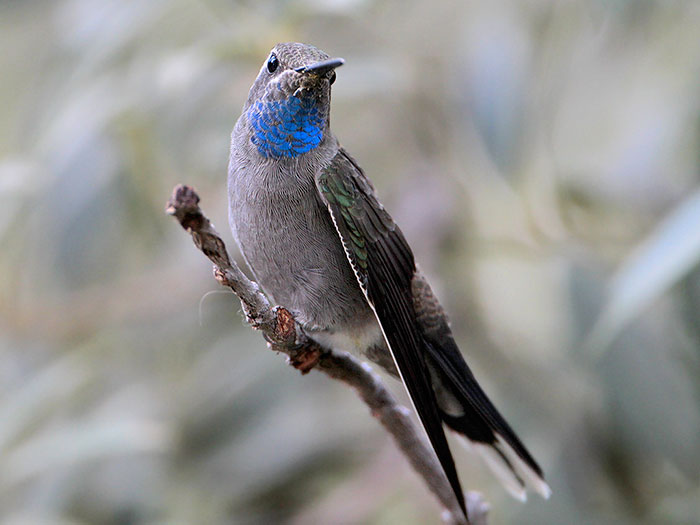
16. Blue-throated Mountain-gem
Size: 5 inches
The Blue-throated Mountain-gem is a big, beautiful hummingbird that lives in southeastern Arizona, adjacent New Mexico, and in a few other scattered sites in the southwestern USA. They also live in highland habitats in many parts of Mexico.
In the USA, this hummingbird species is common along forested streams. Near such habitats, they are also regular at hummingbird feeders.
Blue-throated Mountain-gems are also pretty easy to recognize. They are large, green and gray hummingbirds with big white spots on the corners of their wide, dark tails.
They also have gray-brown on their lower back, brownish underside, and two white lines on their face.
Both sexes are similar, except that males have a beautiful blue throat.
The Blue-throated Mountain-gem isn’t just big; it’s the largest hummingbird in the USA! It is also the northernmost of the Mountain-gems, a group of hummingbird species that live in the mountains of Mexico and Central America.
Types of Hummingbirds – Frequently Asked Questions
What is the most common hummingbird?
The most common hummingbird is the Anna’s Hummingbird. According to eBird, this species is seen more often than any other. However, east of the Rocky Mountains, the most common hummingbird is the Ruby-throated Hummingbird.
What is the biggest hummingbird?
The biggest hummingbird in North America is the Blue-throated Mountain-gem. This hefty hummingbird species is 5 inches long, has an 8-inch wingspan, and weighs .27 ounces. However, the largest hummingbird in the world is the Giant Hummingbird of South America. This swallow-sized hummingbird is 8 inches long!
What is the smallest hummingbird?
The smallest hummingbird in the world is the Bee Hummingbird. This little creature is just over two inches long and native to Cuba! However, the title of the smallest hummingbird in the U.S. belongs to the Calliope Hummingbird.
How many species of hummingbirds are there?
In total, there are around 365 hummingbird species in the world! Most of them live in Central and South America, but some of them live in the U.S. too! In the United States, there are 15-16 species that are easy to spot, but sometimes, even more species make their way to some southern states.
Where are the prettiest hummingbirds?
Hummingbirds are found in North and South America, so it’s possible to find them there. When it comes to choosing the prettiest, beauty is in the eye of the beholder!
Which hummingbirds have you seen? Tell us about your favorite hummingbird experiences in the comments!


